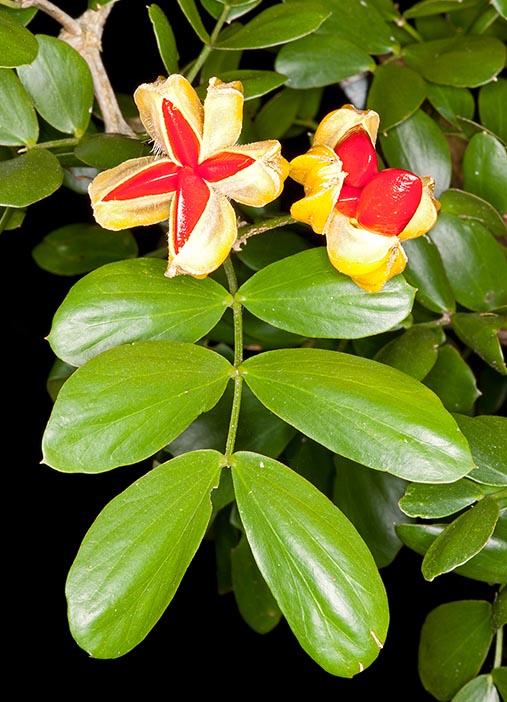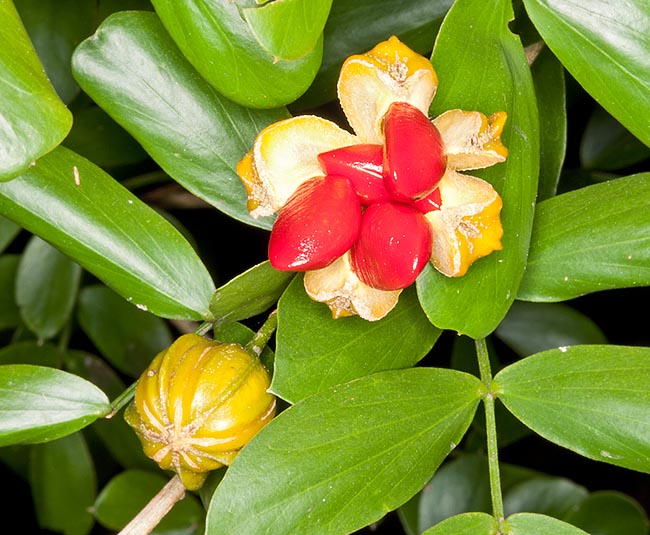Family : Zygophyllaceae

Text © Pietro Puccio

English translation by Mario Beltramini

Guaiacum sanctum was deemed to cure any illness © Giuseppe Mazza
The species is native to Bahamas, Costa Rica, El Salvador, Guatemala, Hispaniola, Honduras, Mexico (Campeche, Chiapas, Quintana Roo and Yucatan), Nicaragua, Puerto Rico and USA (Florida), where it grows at low altitudes in the dry coastal forests on poor rocky soils.
The name of the genus comes from the Spanish “guayaco” or “gayacan”, in its turn coming from a local name, “guaiac”; the name of the species is the Latin adjective “sanctus, a, um” = sacred, saint, which takes the Spanish common name “palo santo” = sacred tree, because considered as such by the first Spanish settlers and capable to able to cure any ill.
Common names: Bahama lignum vitae, holywood, holywood lignum-vitae, ironwood, lignum vitae, pockwood, tree of life (English); guaiaco bianco (Italian); guaiaco, pau santo, lenha di guaiaco (Portuguese); guayacán blanco, guayacán real, palo santo (Spanish); guayacán blanco, guayacancillo, vara amarilla (Cuba); bois saint, gaïac, bazar, gaïac, blanc, gaïac, cardasse, gaïac, femelle, pyé gaïac, (Haiti); hauxaxan, matlacuahuitl, son, zon (Mexico); palo santo (Puerto Rico).
The Guaiacum sanctum L. (1753) is an evergreen tree with specimens which can reach, in the wild, the 25 m of height, but which, in cultivation, keeps much lower, with gnarled trunk up to 60 cm of diameter and whitish bark with vertical superficial fissures, the young branches are grey and enlarged at the nodes. The leaves are opposite, paripinnate, 3-10 cm long, with 2-5 pairs of sessile (without petiole) leaves, coriaceous, oblong or obovate, entire, mucronate (suddenly ending in an acute point), of dark green colour, 2,5-3,5 cm long and up to 1,7 cm broad, asymmetric in respect to the central nervation.
Terminal fascicular inflorescences, in spring and in autumn, with 4-8 blue or purple flowers with 5 sepals and 5 petals, unguiculate (petals with the long narrow base similar to a stem) and rounded at the apex, 0,7-1,2 cm long and 0,6-0,8 cm broad, and 10 stamina with yellow anthers.
The fruit is an ovoid capsule, about 1,5 cm long and up to 1,8 cm broad, of orange yellow colour with 2-5 prominent lobes which open to uncover the ellipsoid seeds, about 1 cm long, of blackish colour enclosed in a bright red aril. It reproduces by seed, cleaned from the aril, as this contains inhibitors, which is to be slightly scarified and immersed in water for 12 hours, to facilitate the germination that takes place, if it is fresh, in 10-20 days as an average.
Species of particularly slow growth, is cultivable in the tropical and subtropical climate zones in full sun, for the best growth, or slight shade, is not particular about the soil, even if poor; well rooted plants can resist to periods of drought. Of great ornamental and landscape value, it can be utilized as isolated specimen or in rows for flanking avenues; it resists the wind and the saltiness, and therefore can be employed close to the sea. It is cultivable also in pot, where it requires limited prunings, and is also an excellent subject for bonsais.

The fruit is an ovoid capsule with black seeds in red arils. Antiseptic resin and hard self-lubricating wood © Mazza
Bark, leaves and in particular the resin exuded are, since remote times, utilized in the popular medicine for various pathologies, in Europe the guaiacum was employed for long time in the treatment of syphilis, despite the absence of pharmacological effects.
The resin is composed manly by guaiacol, used in medicine as antiseptic for the respiratory tract, besides saponins, terpins and minor compounds.
It is the hardest wood and with the highest density (up to 1370 kg/m3), its high contents of resin (up to the 26%), which acts as lubricant, has meant that in the past it was amply utilized for fabricating gears, pulleys, bearings and shafts, and due to its hardness for tools, equipment, percussion instruments, besides furniture, handicrafts and in marine applications, due to its resistance to the water; furthermore, always thanks to the resin, is resistant to the insects attacks. In the past, the leaves were utilized, because of their high detergent power, as surrogate of the soap; the essential oil is still nowadays utilized in the perfume industry.
The Guaiacum sanctum is the national tree of the Bahamas. The indiscriminate exploitation, which lasted until recent times, has drastically reduced the presence of this species in the wild, consequently, actions were taken, both locally and internationally, for its preservation. The species is presently inserted into the appendix II of the CITES (species whose trade is internationally ruled); the International Union for Conservation of Nature (IUCN) has placed it in the list of the plants at very high risk of extinction in nature in the forthcoming future (“endangered”).
Synonyms: Guaiacum verticale Ortega (1798); Guaiacum multijugum Stokes (1812); Guaiacum parvifolium Nutt. (1849); Guaiacum sloanei Shuttlew. ex A.Gray (1852); Guaiacum guatemalense Planch. ex Hemsl. (1879); Guaiacum guatemalense Planch. ex Rydb. & Vail (1910).
